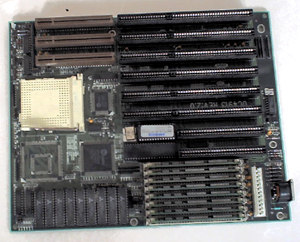|
It
is often easy to overlook the origins of humanity with
all that we have accomplished today. Take a look at where
you are, see where you have been. Sometimes it is important
to know the past, to greater understand the future. Undoubtedly,
this phrase greatly applies to the computer technology
of today. Rapid advancement of hardware has led to more
capable software, along with more versatile uses. Unfortunately,
we did not always have the power in computers that there
is today. The first range of personal computers often
did little more than run simple programs no more complex
than word processors. Of course, the power we perceive
in technology today will be dwarfed by what progress that
is made in the future. By taking a look at how hardware
got to its point today, you can gain better understanding
of the computing field as a whole.
This
motherboard was equipped with 8 256k simms, no onboard
IDE, and supported a blazing 386:

Motherboards
have come a very long way from day one. Current motherboard
manufacturers often struggle to pack as many features
into their new motherboard as possible. The more features
a motherboard has, the more incentive there is to buy
it. This was not always the case, many older motherboards
were nothing but bare bones. Equipped with nothing more
than four standard ISA slots, a few ram banks, and a CPU
socket, its easy to see there was a lot of improvement
to be made. IDE controllers were add-in cards, along with
all other necessities such as serial and parallel ports.
There was no easily configurable soft-bios, nor much room
for upgrades. Now days you see everything from onboard
sound, and video, to special hardware controllers such
as RAID technology. Because of the need to buy many add-on
boards for basic functions such as mouse support, expandability
was very limited. After buying a card for serial ports,
printer ports, soundcard, video card, and a hardware controller,
if you were left with any open slots it was a stroke of
luck. As such external modems were widely popular, as
saving one slot was beyond useful.
Next
>>
|